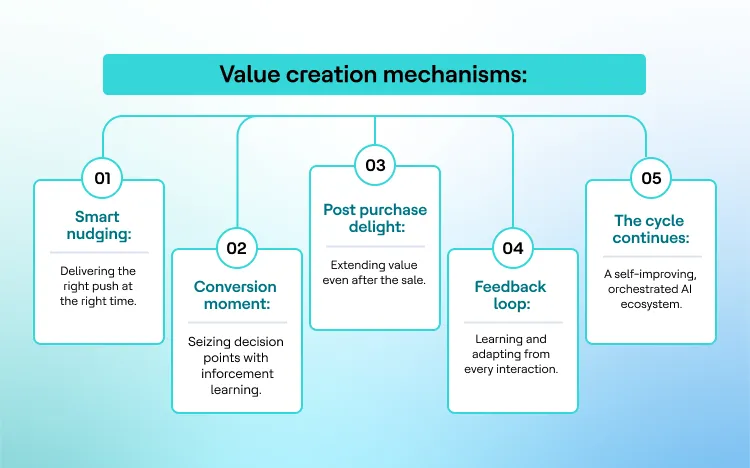AI has evolved beyond singular technology into a spectrum of intelligence systems, orchestrating seamless, innovative, and personalized customer experiences. From statistical models to multi-agent orchestration, this progression accelerates daily. The critical question isn’t what AI can do; it’s how far we can push it to deliver meaningful, human-like interactions at scale. This trajectory has two components: automation and fidelity.
What is Automation?
In its simplest form, automation is about offloading repetitive tasks to machines. In the context of AI, it's about using predictive, generative, and agentic models to reduce manual intervention and speed up outcomes. Early AI handled things like:
- Subtle discovery using descriptive AI
- Contextual targeting via predictive AI
At this stage, AI functions as a smart assistant, processing data, identifying patterns, and expediting decisions. McKinsey research1 shows companies achieve 10-15% efficiency gains through automation. But automation can only get you so far.
Fidelity: Where AI Develops Context
Fidelity is about depth, the richness, and contextual intelligence of AI interactions. Automating a task is not enough; it must feel human, helpful, and hyper-relevant. Fidelity emerges when automation meets personalization and decision-making.
This stage brings in:
- Personalized engagement through prescriptive AI. For instance, a retail company can analyze browsing behavior, social media activity, and purchase history to adjust its messaging dynamically.
- Tailored content via generative AI. For instance, a bank can generate personalized financial summaries for customers, tailoring the language to their geographical location and offering relevant financial advice based on their habits. Per PwC’s 2025 AI Business Predictions2, 73% of executives plan to use GenAI to reshape their business model.
- Seamless follow-up with agentic AI. For example, an airline can manage flight disruptions by detecting real-time cancellations, rebooking, and notifying users about the updated itinerary via app or email.
AI now adapts in real time, speaks your customer’s language, and keeps the experience going. It stops reacting and starts anticipating.
What Makes AI Fidelity Essential?
High-fidelity AI enhances efficiency, thereby building trust. When AI understands context, preferences, and timing, it generates meaningful moments for the customer.

At this maturity level, AI evolves from a tool into a strategic system—a multi-agent framework that orchestrates customer journeys without consuming human bandwidth.
Conclusion
The trajectory of AI is moving fast: from statistical models to agentic systems delivering deeply personal, self-improving experiences. As automation becomes the baseline, fidelity becomes the differentiator. The brands that succeed will be the ones that adopt AI not just to do things faster but to do them better, smarter, and more human.
This is just the beginning. In this blog series, we’ll explore how these principles come to life:
- Real-time personalization powered by predictive and generative models
- Autonomous campaigns with self-adjusting engagement algorithms based on intent
- Feedback-driven orchestration where AI learns and evolves with each interaction
Stay tuned! We’re deconstructing the future of marketing automation, one intelligent layer at a time.
Source:
Start a Conversation with Us
We’re here to help you find the right solutions and support you in achieving your business goals.








